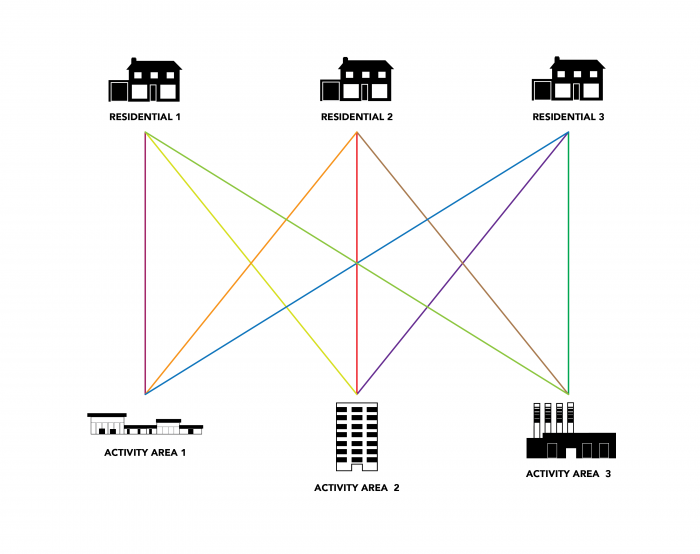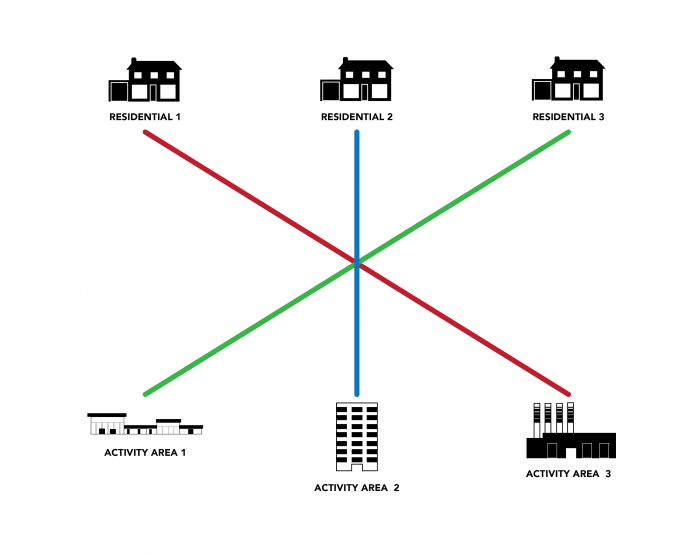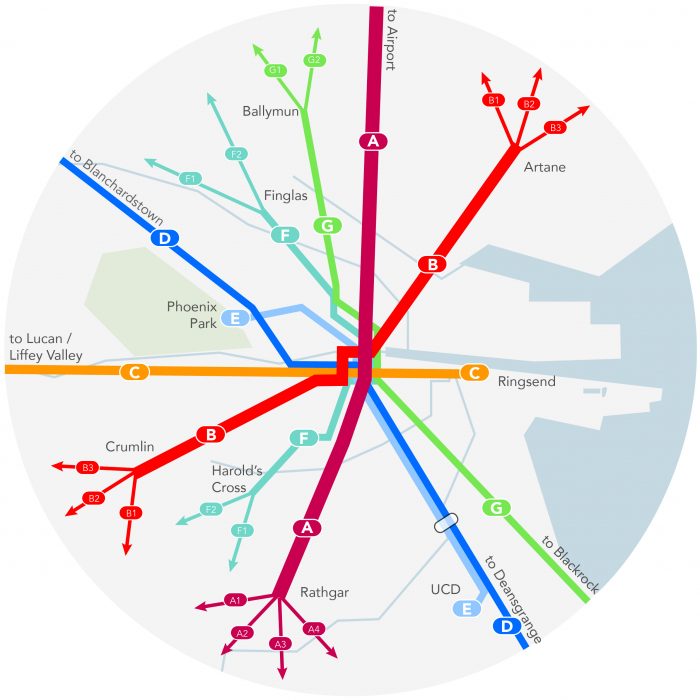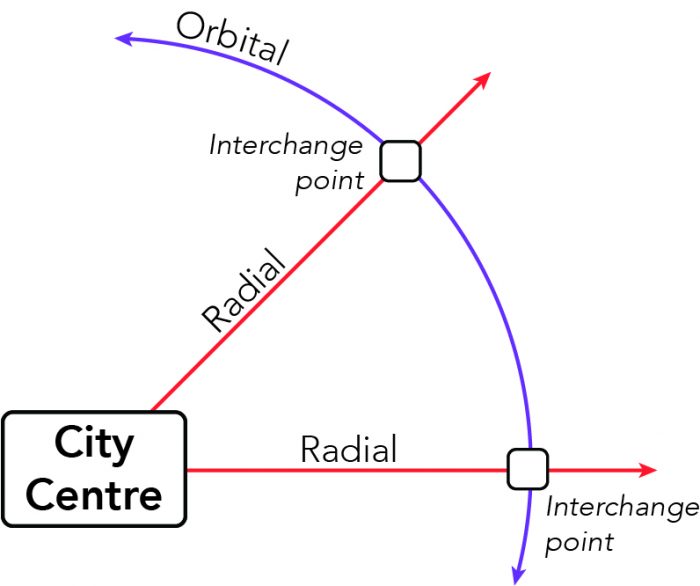This is a overview of the key issues and choices that we are currently considering in the Dublin Area Bus Network Redesign. A quick read of this article will give you useful background for answering the survey. For more detail about our analysis of the existing system and Dublin’s patterns of demand, see the full Choices Report, which can be downloaded here.
In reviewing the existing network, we have noted several issues:
- Many overlapping lines, each with their own frequency, prevent buses from being evenly spaced to minimize waiting. Along with low frequency on some lines, this means many people wait longer than they need to.
- Complexity. The sheer number of lines and branches is a barrier to understanding the network, and discourages many trips for which service could be useful.
- Too many buses in the City Centre. Many streets carry extremely high volumes of buses, which produce major delay by buses blocking each other.
- Poor Orbital Service. There is abundant service into and out of the City Centre, but poor service for travel between other destinations, especially between origins and destinations on the same side of the city.
The foundation of many of these problems is the current assumption that the network should minimize the need for interchange — that is, for people to get off one bus and onto another bus or train.
This article explores what might be gained, and what trade-offs would occur, in a network design that was based on accepting an increased degree of interchange to unlock major solutions to all the problems above.
Assumptions
In thinking about this, please make these assumptions:
- Fare penalities for interchanging are removed. Your fare does not depend on whether an interchange is required. A parallel project is working on this issue.
- The network does not increase overcrowding. In detailed planning we will ensure that adequate service is provided to meet capacity needs.
- Shelters and real time information about bus arrivals are found at every interchange stop.
- Any walk required for the interchange is safe, efficient, and short.
- Reliability continues to improve, through added bus lanes and other tools that reduce disruption and delay. A parallel project is working on this issue.
How Connections Improve Travel Time
It sounds strange, but a network that requires customers to interchange, usually no more than once per trip, can get you to your destination sooner. Here is how.
Imagine a simple city that has three primary residential areas, along the top in the diagram to the right, and three primary activities of employment or activity, along the bottom.
In designing a network for this city, the first idea is to run direct service from each residential area to each activity center. If we have three of each, this yields a network of nine transit lines.
Suppose that we can afford to run each line every 30 minutes. Call this the Direct Service Option.
Now consider another way of serving this simple city for the same cost. Instead of running a direct line between every residential area and every activity center, we run a direct line from each residential area to one activity center, but we make sure that all the resulting lines connect with each other at an interchange point in the middle
Now we have three lines instead of nine, so we can run each line three times as often at the same total cost as the Direct Service option. So instead of service every 30 minutes, we have service every 10 minutes. Let’s call this the Connective Option.
The Direct Service option seems to be the obvious solution. But if we want to maximize people’s ability to get places with our fixed budget, we should prefer the Connective option.
Consider how long a typical trip takes in each scenario, from the standpoint of a person whose needs to leave or arrive at a particular time. Let’s look at a trip from the rightmost residential area to the middle activity centre.
In the Direct Service Option, this trip has direct service. It runs every 30 minutes, so on average, the waiting time is 15 minutes.
Now look at the Connective Option. Your first bus runs every 10 minutes, so you’ll wait, on average 5 minutes. The same thing will happen at the interchange point, where you change to the bus to your destination. That’s 10 minutes of waiting instead of 15.
So the Connective Network is faster, even though it requires interchange, because of the much higher frequencies that it can offer for the same total budget.
In a larger city, this benefit becomes even larger. For example, if there were ten residential areas and ten activity centres, the buses in the Connective network would come every three minutes, and a trip requiring interchange would be 12 minutes faster than in the Direct Service option.
Other Advantages of Connective Networks
In addition to the faster total trip time, there are other reasons to prefer Connective networks over Direct Service networks.
- Frequency. The Connective network is made of more frequent services. Frequency delivers three independent benefits that make all the difference in whether public transport is useful:
- You go when you want to go.
- It is easy to interchange to other frequent lines, which is the key to a network that lets you go all over the city quickly, and by direct paths.
- You are less likely to be affected by a disruption, because whatever happens to a bus, the next one will be along soon.
- Simplicity. A network of a few frequent lines is much easier to remember than a network of many infrequent ones. This makes it easy to learn the network quickly, and to keep it in your head as you move freely about the city.
Disadvantages of Connective Networks
Nevertheless, connective networks have downsides. Here are the most common reasons to dislike them.
The largest disadvantage is simply the effort required. Partway through your journey, you must gather your things, exit the bus, walk to another stop, and wait for another bus. The walk will be very short, always well under 100m, and the high frequencies mean that the wait will be short as well. Excellent shelter and information will also be provided at every interchange location. But it will still be an inconvenience. The level of effort may also be greater for people with limited mobility.
The second disadvantage is that interchange can compound risks associated with reliability. There is always the fear of missing a connecting bus and being stuck at the interchange point. In a connective network, this will only occur in cases of major disruption. In routine operations, there are so many buses along each route that waits will be very short. Again, NTA is working on a parallel project to improve reliability throughout the network.
So how do you weight the advantages against the disadvantages. That’s the most important question we are asking you during the survey period, in June 2017.
Possible Strategy: Very Frequent Lines into and across Central Dublin
The survey will ask you how you feel about a more connective network, based on what we have said up to now. But it will also ask you about two specific strategies that might be used. If you read about these strategies, you’ll gain a more detailed understanding of how a connective approach might change Dublin’s bus network. The survey asks you about these two strategies individually. This section and the next explain the possible strategies.
Here is a simplified diagram of how radial bus lines are organised along the highest-volume corridors in Dublin. Each major corridor has several overlapping bus lines, which do different things on the opposite side of the City Centre.
For example, two overlapping frequent lines from Ballymun approach the City Centre from the north, but one continues south west to Harold’s Cross while the other continues south east toward Blackrock. The advantage of this scheme is that each major street has direct service to several different major streets on the opposite side of the city, reducing the need to change buses.
But there are at least two disadvantages to the existing pattern:
- Direct service requires waiting for a particular bus rather than taking whichever is coming next. This means lower frequency and thus longer waits.
- The number of cross-city bus patterns creates huge complexity in the City Centre. Dozens of lines weave in different directions from different origins, so there are few locations to wait for all buses going out on a given corridor. It is also hard to identify frequent paths useful for short trips in and near the City Centre.
Alternative Concept – High Frequency Spines
Here is another way this could work. Imagine if, instead of having direct service from each corridor to several others, all service in a corridor could flow through to a single corridor on the other side.
These services would run together to a certain point, then branch to serve multiple destinations further out. These outer points are branches, not additional interchanges. Everyone on all branches would still have direct, no-interchange service to the City Centre. Buses from the spines would flow through to one of these branches, most of which would run every 15 minutes or better. For example, at the bottom of the image, buses from routes A1 through A4 would merge to form the very frequent spine A)
The combined service would form a spine of extreme frequency, in the range of a bus every 3 to 6 minutes in the middle of the day. This could also provide other benefits:
- Simpler Cross City paths. Short trips across the City Centre would be easier, because frequency would always be very high and the network would be simple to learn, remember, and navigate.
- Better ability to match service to observed loads. As service is concentrated in fewer bus lines, it becomes easier to adjust bus volume on each line to match real demand.
- Reduced bus congestion in City Centre. Fewer frequent lines are easier to schedule so that buses are not obstructing one another. The total number of bus trips traversing the centre would be somewhat lower, without any reduction in service to the customer.
Cross City Travel Time Examples
Here a few examples of how cross public transport travel times might change. For simplicity, let us assume that buses on each spine come every four minutes. This is possible based on current service volumes.
Harold’s Cross to Drumcondra
This trip is currently direct but would require an interchange in the new concept. In the existing network, this trip would use Line 16:
- Wait 6 minutes + Travel 34 minutes = 40 minutes
In the suggested alternative, you would take F and interchange to A:
- Wait 2 minutes + Travel 24 minutes + Wait 2 minutes + Travel 10 minutes = 38 minutes
Donnybrook to Heuston Station
In the existing network, this trip would use Line 145:
Wait 5 minutes + Travel 25 minutes = 30 minutes
In a restructured network with spines, you would use D to C.
Wait 2 minutes + Travel 17 minutes + Wait 2 minutes + Travel 8 minutes = 29 minutes
Note that you could also use Luas for the trip from the City Centre to Heuston Station.
Lucan to UCD Belfield
This trip already requires an interchange. In the existing network, you would use 66/a/b and change to line 39a:
Wait 5 minutes + Travel 20 minutes + Wait 7.5 minutes + Travel 24 minutes = 56.5 minutes
In a restructured network with spines, you would use spines C and E:
Wait 2 minutes + Travel 20 minutes + Wait 2 minutes + Travel 24 minutes = 49 minutes
Ballymun to a point near Blackrock
This trip is direct in the existing network, and would continue to be. In the existing network, this trip would use Line 4:
Wait 7.5 minutes + Travel 52 minutes = 59 minutes
In a restructured network with spines, this would change to:
Wait 2.5 minutes + Travel 52 minutes = 54.5 minutes
All these trips would be faster, even if an interchange were newly required.
Possible Strategy: Building Frequent Orbitals by Reducing Duplication
Here is what we mean by orbital services, as opposed to the radial services discussed above.
It is currently difficult to travel between points that are generally on the same side of the city, without going through the City Centre. That’s because there are few orbital lines, and those that exist are so infrequent that it is difficult to interchange to them.
Here is one way to increase the frequency of orbitals. The image on the left shows a typical arrangement of radials, where red means frequent and purple means infrequent. The image on the right shows another way it could work at a similar cost.

In these drawings RED MEANS FREQUENT (the bus comes every 10 minutes or better). PURPLE means infrequent (the bus comes every 20 minutes or worse).
Note: this is just an example. Rotate the drawings as you like to see how the same principle could apply all around the city.
In general, for the same reason outlined in the last examples, trips to the City Centre from points now on the purple lines would be faster, even with the newly required interchange, because the orbital frequency would be higher.
In addition, it would suddenly be possible to make many other trips much more quickly, because wherever red lines cross, interchange would be possible with minimal delay. That means you can use the orbital together with any of the radials to make trips within your side of the city, without going through the City Centre.
Questions for You
To sum up, the most important choice facing the Dublin bus network is whether to increase the reliance on interchanging, in return for service that is more frequent and less complex, and that offers faster total journey times even for trips where an interchange is newly required.
This article has illustrated the advantages and disadvantages, and also has laid out some examples of the kinds of changes that might appear in a plan that embraces the high-interchange, high-frequency principle.
Still, it is a choice, one that the NTA will need to make based on the advice from the public.
In June 2017, a web survey will ask you to offer your advice whether NTA should move in the suggested direction, and how far. Providing advice at this stage will be especially helpful and influential, because you will be guiding the plan instead of just responding to it.
Again, when thinking about this choice, please make the following assumptions, which reflect parallel planning processes now underway within the larger BusConnects programme.
- Fare penalities for interchanging are removed. Your fare does not depend on whether an interchange is required.
- The network does not increase overcrowding. In detailed planning we will ensure that adequate service is provided to meet capacity needs.
- Adequate shelters and information are found at every interchange stop.
- Any walk required for the interchange is safe, efficient, and short.
- Reliability continues to improve, through added bus lanes and other tools that reduce disruption and delay.
Thank you for reading. We look forward to your thoughts on the possible strategies we’ve presented.





